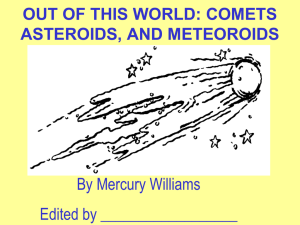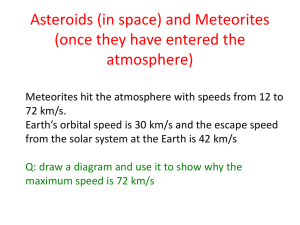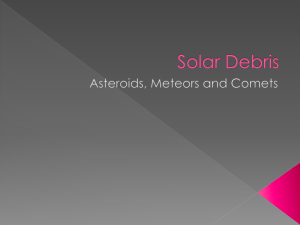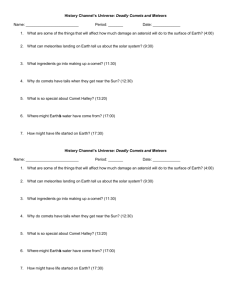News Exam 4/Final is Saturday December 9 at 2:00 p.m. here... Clark 107
advertisement
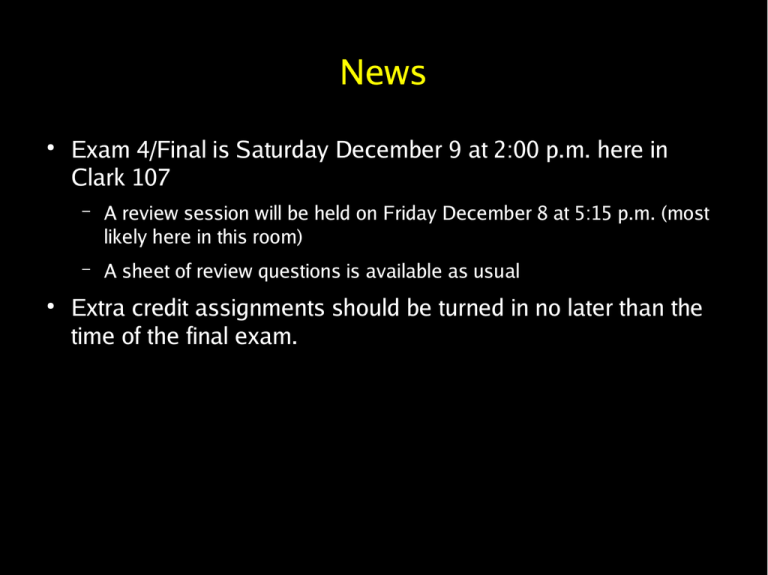
News ● ● Exam 4/Final is Saturday December 9 at 2:00 p.m. here in Clark 107 – A review session will be held on Friday December 8 at 5:15 p.m. (most likely here in this room) – A sheet of review questions is available as usual Extra credit assignments should be turned in no later than the time of the final exam. Solar System Debris: Comets and Asteroids ● Primarily found in two zones in the solar system. The Asteroid Belt (rocky, between Jupiter and Mars) The Edgeworth/Kuiper Belt (icy, beyond Neptune – source of comets) Solar System Debris: Comets and Asteroids ● Why do these things exist?.... Solar system formation is a messy process. Solar System Debris: Comets and Asteroids ● Planets sweep up and fling out most of the debris but stable zones remain. Solar System Debris: Comets and Asteroids ● Jupiter interfered with the formation of a planet between Mars and Jupiter. Some fraction of the debris remains today as the asteroid belt. – Jupiter stirred up the planetesimals so that collisions were violent rather than gentle. Solar System Debris: Comets and Asteroids ● Beyond the orbit of Neptune material was sparse and planetary accumulation times were very slow. Some icy planetesimals remain. – Occasionally one has an orbit modified so that it falls into the inner Solar System. Warmed by the Sun, ices sublimate away and dust is released making a “ comet” . Asteroids ● Asteroids are small, rocky, cratered and irregularly shaped. – They are the collisionally modified remains of leftover planetesimals between the orbits of Mars and Jupiter. Asteroids ● Asteroids are small, rocky, cratered and irregularly shaped. – They are the collisionally modified remains of leftover planetesimals between the orbits of Mars and Jupiter. Asteroids ● Asteroids are small, rocky, cratered and irregularly shaped. – Asteroids are irregularly shaped because they are basically big rocks. Their gravity is insufficiently strong to deform them into a spherical shape. Asteroids ● Millions of these objects orbit in the Asteroid belt – staying between Mars and Jupiter. – Some have orbits that cross the inner planets. Asteroids ● Some asteroids are “ binary” objects. Asteroids ● The original “ parent bodies” that were the predecessors of the asteroids were large enough to differentiate. – some asteroids are metallic, consisting of the core fragments of a large parent body. – the largest asteroids may be intact parent bodies. An upcoming space mission (DAWN) targets two of the largest – Ceres and Vesta. Asteroids and Meteorites ● Meteorites that fall to are just small asteroids. They tell the story of the differentiation and fragmentation of the asteroids. – Some are entirely metallic, some are stony, some appear to come from unmodified undifferentiated objects. Asteroids and Meteorites ● Meteorites that fall to are just small asteroids. They tell the story of the differentiation and fragmentation of the asteroids. – Some are entirely metallic, some are stony, some appear to come from unmodified undifferentiated objects. Asteroids and Meteorites ● Meteorites that fall to are just small asteroids. They tell the story of the differentiation and fragmentation of the asteroids. – Meteorites are often spectral fingerprint matches to distant asteroids. You can hold a piece of Vesta in your hand with certainty. Meteorites ● There are four major classes of meteorites – Stones: rocky meteorites with iron flecks. – Stones represent the majority of “ falls” but are found in equal numbers with “ iron” meteorites. Meteorites ● There are four major classes of meteorites – Stones tend to be composed of chondrules – glassy beads making up most of the mass of the rock. – Astronomers still argue about the origin of chondrules – how did these glassy beads form during the formation of the Solar System? Meteorites ● There are four major classes of meteorites – Irons represent the other significant type of meteorite. – Only about 6% of “ falls” are irons, but they represent the majority of “ finds” because they are so recognizable as something completely odd. Meteorites ● There are four major classes of meteorites – Irons represent the other significant type of meteorite. – When etched with nitric acid a crystalline patter appears in cross sections of iron meteorites. – This pattern can only arise from the slow cooling of molten iron (one degree every million years) consistent with formation in the center of a huge differentiated asteroid! Meteorites ● There are four major classes of meteorites – “ Stony-iron” meteorites (a.k.a. Pallasites) appear to have come from the core-mantle boundary in a differentiated asteroid. They are quite rare. Meteorites ● There are four major classes of meteorites – “ Carbonaceous chondrites are possibly the most interesting of meteorites of all. They represent about 1% of falls. – Carbonaceous chondrites are undifferentiated and largely unprocessed. They must come from small parent objects too small to become hot and melt and differentiate. – Some carbonaceous chondrites contain amino acids formed in the Solar Nebula – the building blocks of protiens. Meteorites ● Meteorites are important astronomically because they represent material preserved from the time of the origin of the Solar System. – Recall that radioactive dating uniformly finds an age of 4.56 billion years for all of these objects. Meteorites ● A few, exceptionally rare, meteorites originate from the surface of the Moon and Mars. – Impacts launched these rocks into interplanetary space. Meteorites ● If you want to find a meteorite, go to a place on Earth where Earth-rocks are rare. – Antartica and the Sahara Desert are good choices. Comets ● Icy leftovers of the formation of the Solar System residing beyond the orbit of Neptune but occasionally falling into the inner Solar System The Asteroid Belt (rocky, between Jupiter and Mars) The Edgeworth/Kuiper Belt (icy, beyond Neptune – source of comets) Comets ● Comets are basically “ dirty snowballs” a few kilometers in size. – During the brief time they are close to the Sun, water and CO2 are vaporized and create a cloud of gas and dust around the tiny nucleus. – Pushed away from the Sun by the solar wind and sunlight, this tenuous debris can stretch a distance equal to the diameter of the Earth's orbit. Comets ● Comets are basically “ dirty snowballs” a few kilometers in size. – Comets have two tails ● ● A gas tail pushed directly away from the Sun by solar wind and sunlight A dust tail also pushed away from the Sun, but with some memory of the comet's path. Comets ● Comets are basically “ dirty snowballs” a few kilometers in size. – Comets have two tails ● ● A gas tail pushed directly away from the Sun by solar wind and sunlight A dust tail also pushed away from the Sun, but with some memory of the comet's path. Comets ● Comets are basically “ dirty snowballs” a few kilometers in size. – The comet's nucleus is just a few kilometers in size, but is the source of all of the interesting phenomena. Comets ● Comets originate in the “ Oort Cloud” and the Edgeworth/Kuiper belt. – Collisions and gravitational tugs can send them falling into the inner solar system.


